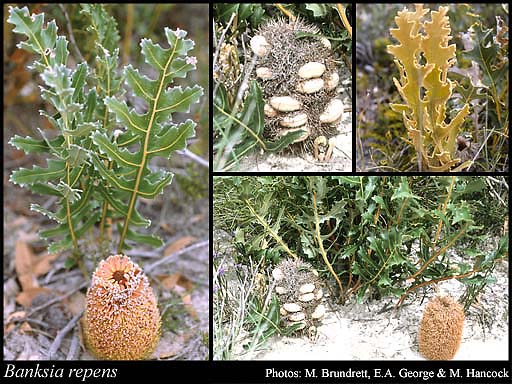- Reference
- Voy.Rech.Perouse 1:411,Tab.23 (1800)
- Conservation Code
- Not threatened
- Naturalised Status
- Native to Western Australia
- Name Status
- Current
Prostrate, lignotuberous shrub, to 0.4 m high. Fl. cream & pink/brown-orange-yellow, Sep to Nov. White or grey sand, sandy loam, sometimes with gravel. Sandplains, consolidated coastal dunes.

Scientific Description
Prostrate shrubs, 0.40-0.7 m high; branchlets hairy. Leaves petiolate, alternate, 150-370 mm long, 50-100 mm wide, hairy; petiole 80-130 mm long; lamina flat, once divided, pinnately divided, deeply divided, with 8-12 lobes on each side, the margins revolute. Inflorescences tomentose (with matted or tangled, soft, woolly hairs), cream, yellow, orange, pink or brown, hairy. Perianth 20-25 mm long, hairy, all over, limb apex hirsute (with long, rough and coarse hairs), without awns; pistil 25-30 mm long, curved, style glabrous. Follicles hairy, tomentose (with matted or tangled, soft, woolly hairs), elliptic, 20-40 mm long. Flowers in September, October or November. Occurs in the South-west (SW) Botanical Province(s), in the Avon Wheatbelt (AW), Jarrah Forest (JF), Mallee (MAL) or Esperance Plains (ESP) IBRA subregion(s).
Distribution
- IBRA Regions
- Avon Wheatbelt, Esperance Plains, Jarrah Forest, Mallee.
- IBRA Subregions
- Eastern Mallee, Fitzgerald, Katanning, Recherche, Southern Jarrah Forest, Western Mallee.
- IMCRA Regions
- Eucla, WA South Coast.
- Local Government Areas (LGAs)
- Albany, Cranbrook, Esperance, Gnowangerup, Jerramungup, Plantagenet, Ravensthorpe.